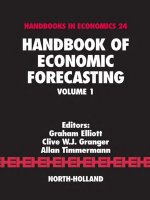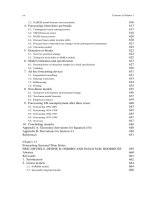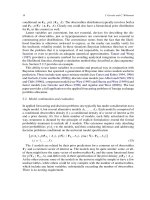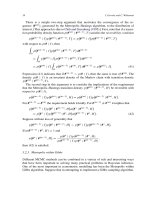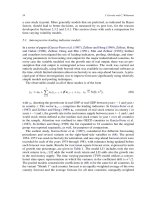Handbook of Economic Forecasting part 5 doc
Bạn đang xem bản rút gọn của tài liệu. Xem và tải ngay bản đầy đủ của tài liệu tại đây (133.65 KB, 10 trang )
14 J. Geweke and C. Whiteman
conditional on θ
A
, p(z | θ
A
,A). The observables distribution typically involves both z
and θ
A
: p(Y
T
| z, θ
A
,A). Clearly one could also have a hierarchical prior distribution
for θ
A
in this context as well.
Latent variables are convenient, but not essential, devices for describing the dis-
tribution of observables, just as hyperparameters are convenient but not essential in
constructing prior distributions. The convenience stems from the fact that the likeli-
hood function is otherwise awkward to express, as the reader can readily verify for
the stochastic volatility model. In these situations Bayesian inference then has to con-
front the problem that it is impractical, if not impossible, to evaluate the likelihood
function or even to provide an adequate numerical approximation. Tanner and Wong
(1987) provided a systematic method for avoiding analytical integration in evaluating
the likelihood function, through a simulation method they described as data augmenta-
tion. Section 5.2.2 provides an example.
This ability to use latent variables in a routine and practical way in conjunction with
Bayesian inference has spawned a generation of Bayesian time series models useful in
prediction. These include state space mixture models [see Carter and Kohn (1994, 1996)
and Gerlach, Carter and Kohn (2000)], discrete state models [see Albert and Chib (1993)
and Chib (1996)], component models [see West (1995) and Huerta and West (1999)] and
factor models [see Geweke and Zhou (1996) and Aguilar and West (2000)]. The last
paper provides a full application to the applied forecasting problem of foreign exchange
portfolio allocation.
2.3. Model combination and evaluation
In applied forecasting and decision problems one typically has under consideration not a
single model A, but several alternative models A
1
, ,A
J
. Each model is comprised of
a conditional observables density (1), a conditional density of a vector of interest ω (8)
and a prior density (9). For a finite number of models, each fully articulated in this
way, treatment is dictated by the principle of explicit formulation: extend the formal
probability treatment to include all J models. This extension requires only attaching
prior probabilities p(A
j
) to the models, and then conducting inference and addressing
decision problems conditional on the universal model specification
p(A
j
), p(θ
A
j
| A
j
), p(Y
T
| θ
A
j
,A
j
), p(ω | Y
T
, θ
A
j
,A
j
)
(15)(j = 1, ,J).
The J models are related by their prior predictions for a common set of observables
Y
T
and a common vector of interest ω. The models may be quite similar: some, or all,
of them might have the same vector of unobservables θ
A
and the same functional form
for p(Y
T
| θ
A
,A), and differ only in their specification of the prior density p(θ
A
| A
j
).
At the other extreme some of the models in the universe might be simple or have a few
unobservables, while others could be very complex with the number of unobservables,
which include any latent variables, substantially exceeding the number of observables.
There is no nesting requirement.
Ch. 1: Bayesian Forecasting 15
2.3.1. Models and probability
The penultimate objective in Bayesian forecasting is the distribution of the vector of
interest ω, conditional on the data Y
o
T
and the universal model specification A =
{A
1
, ,A
J
}.Given(15) the formal solution is
(16)p
ω | Y
o
T
,A
=
J
j=1
p
ω | Y
o
T
,A
j
p
A
j
| Y
o
T
,
known as model averaging. In expression (16),
(17)p
A
j
| Y
o
T
,A
= p
Y
o
T
| A
j
p(A
j
| A)
p
Y
o
T
| A
(18)∝ p
Y
o
T
| A
j
p(A
j
| A).
Expression (17) is the posterior probability of model A
j
. Since these probabilities sum
to 1, the values in (18) are sufficient. Of the two components in (18) the second is the
prior probability of model A
j
. The first is the marginal likelihood
(19)p
Y
o
T
| A
j
=
A
j
p
Y
o
T
| θ
A
j
,A
j
p(θ
A
j
| A
j
) dθ
A
j
.
Comparing (19) with (10), note that (19) is simply the prior predictive density, evaluated
at the realized outcome Y
o
T
– the data.
The ratio of posterior probabilities of the models A
j
and A
k
is
(20)
P(A
j
| Y
o
T
)
P(A
k
| Y
o
T
)
=
P(A
j
)
P(A
k
)
·
p(Y
o
T
| A
j
)
p(Y
o
T
| A
k
)
,
known as the posterior odds ratio in favor of model A
j
versus model A
k
. It is the prod-
uct of the prior odds ratio P(A
j
| A)/P (A
k
| A), and the ratio of marginal likelihoods
p(Y
o
T
| A
j
)/p(Y
o
T
| A
k
), known as the Bayes factor. The Bayes factor, which may be
interpreted as updating the prior odds ratio to the posterior odds ratio, is independent
of the other models in the universe A ={A
1
, ,A
J
}. This quantity is central in sum-
marizing the evidence in favor of one model, or theory, as opposed to another one, an
idea due to Jeffreys (1939). The significance of this fact in the statistics literature was
recognized by Roberts (1965), and in econometrics by Leamer (1978). The Bayes factor
is now a practical tool in applied statistics; see the reviews of Draper (1995), Chatfield
(1995), Kass and Raftery (1996) and Hoeting et al. (1999).
2.3.2. A model is as good as its predictions
It is through the marginal likelihoods p(Y
o
T
| A
j
)(j = 1, ,J) that the observed
outcome (data) determines the relative contribution of competing models to the poste-
rior distribution of the vector of interest ω. There is a close and formal link between a
model’s marginal likelihood and the adequacy of its out-of-sample predictions. To es-
tablish this link consider the specific case of a forecasting horizon of F periods, with
16 J. Geweke and C. Whiteman
ω
= (y
T +1
, ,y
T +F
).Thepredictive density of y
T +1
, ,y
T +F
, conditional on the
data Y
o
T
and a particular model A is
(21)p
y
T +1
, ,y
T +F
| Y
o
T
,A
.
The predictive density is relevant after formulation of the model A and observ-
ing Y
T
= Y
o
T
, but before observing y
T +1
, ,y
T +F
. Once y
T +1
, ,y
T +F
are
known, we can evaluate (21) at the observed values. This yields the predictive like-
lihood of y
o
T +1
, ,y
o
T +F
conditional on Y
o
T
and the model A, the real number
p(y
o
T +1
, ,y
o
T +F
| Y
o
T
,A). Correspondingly, the predictive Bayes factor in favor of
model A
j
, versus the model A
k
,is
p
y
o
T +1
, ,y
o
T +F
| Y
o
T
,A
j
p
y
o
T +1
, ,y
o
T +F
| Y
o
T
,A
k
.
There is an illuminating link between predictive likelihood and marginal likelihood
that dates at least to Geisel (1975). Since
p(Y
T +F
| A) = p(Y
T +F
| Y
T
,A)p(Y
T
| A)
= p(y
T +1
, ,y
T +F
| Y
T
,A)p(Y
T
| A),
the predictive likelihood is the ratio of marginal likelihoods
p
y
o
T +1
, ,y
o
T +F
| Y
o
T
,A
= p
Y
o
T +F
| A
p
Y
o
T
| A
.
Thus the predictive likelihood is the factor that updates the marginal likelihood, as more
data become available.
This updating relationship is quite general. Let the strictly increasing sequence of
integers {s
j
(j = 0, ,q)} with s
0
= 1 and s
q
= T partition T periods of observa-
tions Y
o
T
. Then
(22)p
Y
o
T
| A
=
q
τ =1
p
y
o
s
τ −1
+1
, ,y
o
s
τ
| Y
o
s
τ −1
,A
.
This decomposition is central in the updating and prediction cycle that
1. Provides a probability density for the next s
τ
− s
τ −1
periods
p
y
s
τ −1
+1
, ,y
s
τ
| Y
o
s
τ −1
,A
,
2. After these events are realized evaluates the fit of this probability density by means
of the predictive likelihood
p
y
o
s
τ −1
+1
, ,y
o
s
τ
| Y
o
s
τ −1
,A
,
3. Updates the posterior density
p
θ
A
| Y
o
s
τ
,A
∝ p
θ
A
| Y
o
s
τ −1
,A
p
y
o
s
τ −1
+1
, ,y
o
s
τ
| Y
o
s
τ −1
, θ
A
,A
,
Ch. 1: Bayesian Forecasting 17
4. Provides a probability density for the next s
τ +1
− s
τ
periods
p
y
s
τ
+1
, ,y
s
τ +1
| Y
o
s
τ
,A
=
A
p
θ
A
| Y
o
s
τ
,A
p
y
s
τ
+1
, ,y
s
τ +1
| Y
o
s
τ
, θ
A
,A
dθ
A
.
This system of updating and probability forecasting in real time was termed pre-
quential (a combination of probability forecasting and sequential prediction) by Dawid
(1984). Dawid carefully distinguished this process from statistical forecasting systems
that do not fully update: for example, using a “plug-in” estimate of θ
A
, or using a pos-
terior distribution for θ
A
that does not reflect all of the information available at the time
the probability distribution over future events is formed.
Each component of the multiplicative decomposition in (22) is the realized value of
the predictive density for the following s
τ
− s
τ −1
observations, formed after s
τ −1
ob-
servations are in hand. In this, well-defined, sense the marginal likelihood incorporates
the out-of-sample prediction record of the model A. Equations (16), (18) and (22) make
precise the idea that in model averaging, the weight assigned to a model is proportional
to the product of its out-of-sample predictive likelihoods.
2.3.3. Posterior predictive distributions
Model combination completes the Bayesian structure of analysis, following the princi-
ples of explicit formulation and relevant conditioning set out at the start of this section
(p. 7). There are many details in this structure important for forecasting, yet to be
described. A principal attraction of the Bayesian structure is its internal logical consis-
tency, a useful and sometimes distinguishing property in applied economic forecasting.
But the external consistency of the structure is also critical to successful forecasting:
a set of bad models, no matter how consistently applied, will produce bad forecasts.
Evaluating external consistency requires that we compare the set of models with unartic-
ulated alternative models. In so doing we step outside the logical structure of Bayesian
analysis. This opens up an array of possible procedures, which cannot all be described
here. One of the earliest, and still one of the most complete descriptions of these pos-
sible procedures is the seminal 1980 paper by Box (1980) that appears with comments
by a score of discussants. For a similar more recent symposium, see Bayarri and Berger
(1998) and their discussants.
One of the most useful tools in the evaluation of external consistency is the posterior
predictive distribution. Its density is similar to the prior predictive density, except that
the prior is replaced by the posterior:
(23)p
Y
T
| Y
o
T
,A
=
A
p
θ
A
| Y
o
T
,A
p
Y
T
| Y
o
T
, θ
A
,A
dθ
A
.
In this expression
Y
T
is a random vector: the outcomes, given model A and the data Y
o
T
,
that might have occurred but did not. Somewhat more precisely, if the time series “ex-
periment” could be repeated, (23) would be the predictive density for the outcome of the
18 J. Geweke and C. Whiteman
repeated experiment. Contrasts between
Y
T
and Y
o
T
are the basis of assessing the exter-
nal validity of the model, or set of models, upon which inference has been conditioned.
If one is able to simulate unobservables θ
(m)
A
from the posterior distribution (more on
this in Section 3) then the simulation
Y
(m)
T
follows just as the simulation of Y
(m)
T
in (11).
The process can be made formal by identifying one or more subsets S of the range
T
of Y
T
. For any such subset P(
Y
T
∈ S | Y
o
T
,A)can be evaluated using the simulation
approximation M
−1
M
m=1
I
S
(
Y
(m)
T
).IfP(
Y
T
∈ S | Y
o
T
,A) = 1 − α, α being a
small positive number, and Y
o
T
/∈ S, there is evidence of external inconsistency of the
model with the data. This idea goes back to the notion of “surprise” discussed by Good
(1956): we have observed an event that is very unlikely to occur again, were the time
series “experiment” to be repeated, independently, many times. The essentials of this
idea were set out by Rubin (1984) in what he termed “model monitoring by posterior
predictive checks”. As Rubin emphasized, there is no formal method for choosing the
set S (see, however, Section 2.4.1 below). If S is defined with reference to a scalar
function g as {
Y
T
: g
1
g(
Y
T
) g
2
} then it is a short step to reporting a “p-value”
for g(Y
o
T
). This idea builds on that of the probability integral transform introduced by
Rosenblatt (1952), stressed by Dawid (1984) in prequential forecasting, and formalized
by Meng (1994); see also the comprehensive survey of Gelman et al. (1995).
The purpose of posterior predictive exercises of this kind is not to conduct hypothesis
tests that lead to rejection or non-rejection of models; rather, it is to provide a diagnostic
that may spur creative thinking about new models that might be created and brought into
the universe of models A ={A
1
, ,A
J
}. This is the idea originally set forth by Box
(1980). Not all practitioners agree: see the discussants in the symposia in Box (1980)
and Bayarri and Berger (1998), as well as the articles by Edwards, Lindman and Savage
(1963) and Berger and Delampady (1987). The creative process dictates the choice of S,
or of g(
Y
T
), which can be quite flexible, and can be selected with an eye to the ultimate
application of the model, a subject to which we return in the next section. In general
the function g(
Y
T
) could be a pivotal test statistic (e.g., the difference between the first
order statistic and the sample mean, divided by the sample standard deviation, in an i.i.d.
Gaussian model) but in the most interesting and general cases it will not (e.g., the point
estimate of a long-memory coefficient). In checking external validity, the method has
proven useful and flexible; for example see the recent work by Koop (2001) and Geweke
and McCausland (2001) and the texts by Lancaster (2004, Section 2.5) and Geweke
(2005, Section 5.3.2). Brav (2000) utilizes posterior predictive analysis in examining
alternative forecasting models for long-run returns on financial assets.
Posterior predictive analysis can also temper the forecasting exercise when it is clear
that there are features g(
Y
T
) that are poorly described by the combination of mod-
els considered. For example, if model averaging consistently under- or overestimates
P(
Y
T
∈ S | Y
o
T
,A), then this fact can be duly noted if it is important to the client.
Since there is no presumption that there exists a true model contained within the set of
models considered, this sort of analysis can be important. For more details, see Draper
(1995) who also provides applications to forecasting the price of oil.
Ch. 1: Bayesian Forecasting 19
2.4. Forecasting
To this point we have considered the generic situation of J competing models relating
a common vector of interest ω to a set of observables Y
T
. In forecasting problems
(y
T +1
, ,y
T +F
) ∈ ω. Sections 2.1 and 2.2 showed how the principle of explicit
formulation leads to a recursive representation of the complete probability structure,
which we collect here for ease of reference. For each model A
j
, a prior model proba-
bility p(A
j
| A), a prior density p(θ
A
j
| A
j
) for the unobservables θ
A
j
in that model,
a conditional observables density p(Y
T
| θ
A
j
,A
j
), and a vector of interest density
p(ω | Y
T
, θ
A
j
,A
j
) imply
p
A
j
, θ
A
j
(j = 1, ,J)
, Y
T
, ω | A
=
J
j=1
p(A
j
| A) · p(θ
A
j
| A
j
) · p(Y
T
| θ
A
j
,A
j
) · p(ω | Y
T
, θ
A
j
,A
j
).
The entire theory of Bayesian forecasting derives from the application of the principle
of relevant conditioning to this probability structure. This leads, in order, to the posterior
distribution of the unobservables in each model
(24)p
θ
A
j
| Y
o
T
,A
j
∝ p(θ
A
j
| A
j
)p
Y
o
T
| θ
Aj
,A
j
(j = 1, ,J),
the predictive density for the vector of interest in each model
(25)p
ω | Y
o
T
,A
j
=
A
j
p
θ
A
j
| Y
o
T
,A
j
p
ω | Y
o
T
, θ
A
j
dθ
A
j
,
posterior model probabilities
p
A
j
| Y
o
T
,A
∝ p(A
j
| A) ·
A
j
p
Y
o
T
| θ
A
j
,A
j
p(θ
A
j
| A
j
) dθ
A
j
(26)(j = 1 ,J),
and, finally, the predictive density for the vector of interest,
(27)p
ω | Y
o
T
,A
=
J
j=1
p
ω | Y
o
T
,A
j
p
A
j
| Y
o
T
,A
.
The density (25) involves one of the elements of the recursive formulation of the
model and consequently, as observed in Section 2.2.2, simulation from the correspond-
ing distribution is generally straightforward. Expression (27) involves not much more
than simple addition. Technical hurdles arise in (24) and (26), and we shall return to a
general treatment of these problems using posterior simulators in Section 3.Herewe
emphasize the incorporation of the final product (27) in forecasting – the decision of
what to report about the future. In Sections 2.4.1 and 2.4.2 we focus on (24) and (25),
suppressing the model subscripting notation. Section 2.4.3 returns to issues associated
with forecasting using combinations of models.
20 J. Geweke and C. Whiteman
2.4.1. Loss functions and the subjective decision maker
The elements of Bayesian decision theory are isomorphic to those of the classical theory
of expected utility in economics. Both Bayesian decision makers and economic agents
associate a cardinal measure with all possible combinations of relevant random elements
in their environment – both those that they cannot control, and those that they do. The
latter are called actions in Bayesian decision theory and choices in economics. The
mapping to a cardinal measure is a loss function in the Bayesian decision theory and
a utility function in economics, but except for a change in sign they serve the same
purpose. The decision maker takes the Bayes action that minimizes the expected value
of his loss function; the economic agent makes the choice that maximizes the expected
value of her utility function.
In the context of forecasting the relevant elements are those collected in the vector of
interest ω, and for a single model the relevant density is (25). The Bayesian formulation
is to find an action a (a vector of real numbers) that minimizes
(28)E
L(a, ω) | Y
o
T
,A
=
A
L(a, ω)p
ω | Y
o
T
,A
dω.
The solution of this problem may be denoted a(Y
o
T
,A). For some well-known special
cases these solutions take simple forms; see Bernardo and Smith (1994, Section 5.1.5) or
Geweke (2005, Section 2.5). If the loss function is quadratic, L(a, ω) = (a −ω)
Q(a −
ω), where Q is a positive definite matrix, then a(Y
o
T
,A) = E(a | Y
o
T
,A); point fore-
casts that are expected values assume a quadratic loss function. A zero-one loss function
takes the form L(a, ω;ε) = 1−
N
ε
(a)
(ω), where N
ε
(a) is an open ε-neighborhood of a.
Under weak regularity conditions, as ε → 0, a → arg max
ω
p(ω | Y
o
T
,A).
In practical applications asymmetric loss functions can be critical to effective fore-
casting; for one such application see Section 6.2 below. One example is the linear-linear
loss function, defined for scalar ω as
(29)L(a, ω) = (1 −q) ·(a − ω)I
(−∞,a)
(ω) + q ·(ω −a)I
(a,∞)
(ω),
where q ∈ (0, 1); the solution in this case is a = P
−1
(q | Y
o
T
,A),theqth quantile of
the predictive distribution of ω. Another is the linear-exponential loss function studied
by Zellner (1986):
L(a, ω) = exp
r(a − ω)
− r(a − ω) −1,
where r = 0; then (28) is minimized by
a =−r
−1
log
E
exp(−rω)
| Y
o
T
,A
;
if the density (25) is Gaussian, this becomes
a = E
ω | Y
o
T
,A
− (r/2)var
ω | Y
o
T
,A
.
The extension of both the quantile and linear-exponential loss functions to the case of a
vector function of interest ω is straightforward.
Ch. 1: Bayesian Forecasting 21
Forecasts of discrete future events also emerge from this paradigm. For example,
a business cycle downturn might be defined as ω = y
T +1
<y
o
T
>y
o
T −1
for some
measure of real economic activity y
t
. More generally, any future event may be denoted
0
⊆ . Suppose there is no loss given a correct forecast, but loss L
1
in forecasting
ω ∈
0
when in fact ω/∈
0
, and loss L
2
in forecasting ω/∈
0
when in fact ω ∈
0
.
Then the forecast is ω ∈
0
if
L
1
L
2
<
P(ω ∈
0
| Y
o
T
,A)
P(ω /∈
0
| Y
o
T
,A)
and ω/∈
0
otherwise. For further details on event forecasts and combinations of event
forecasts with point forecasts see Zellner, Hong and Gulati (1990).
In simulation-based approaches to Bayesian inference a random sample ω
(m)
(m =
1, ,M)represents the density p(ω | Y
o
T
,A). Shao (1989) showed that
argmax
a
M
−1
M
m=1
L
a, ω
(m)
a.s.
→ argmax
a
E
L(a, ω) | Y
o
T
,A
under weak regularity conditions that serve mainly to assure the existence and unique-
nessofargmax
a
E[L(a, ω) | Y
o
T
,A]. See also Geweke (2005, Theorems 4.1.2, 4.2.3
and 4.5.3). These results open up the scope of tractable loss functions to those that can
be minimized for fixed ω.
Once in place, loss functions often suggest candidates for the sets S or functions
g(
Y
T
) used in posterior predictive distributions as described in Section 2.3.3. A generic
set of such candidates stems from the observation that a model provides not only the op-
timal action a, but also the predictive density of L(a, ω) | (Y
o
T
,A)associated with that
choice. This density may be compared with the realized outcomes L(a, ω
o
) | (Y
o
T
,A).
This can be done for one forecast, or for a whole series of forecasts. For example,
a might be the realization of a trading rule designed to minimize expected financial loss,
and L the financial loss from the application of the trading rule; see Geweke (1989b)
for an early application of this idea to multiple models.
Non-Bayesian formulations of the forecasting decision problem are superficially sim-
ilar but fundamentally different. In non-Bayesian approaches it is necessary to introduce
the assumption that there is a data generating process f(Y
T
| θ) with a fixed but un-
known vector of parameters θ, and a corresponding generating process for the vector
of interest ω, f(ω | Y
T
, θ). In so doing these approaches condition on unknown quan-
tities, sewing the seeds of internal logical contradiction that subsequently re-emerge,
often in the guise of interesting and challenging problems. The formulation of the fore-
casting problem, or any other decision-making problem, is then to find a mapping from
all possible outcomes Y
T
, to actions a, that minimizes
(30)E
L
a(Y
T
), ω
=
T
L
a(Y
T
), ω
f(Y
T
| θ)f (ω | Y
T
, θ) dY
T
dω.
Isolated pedantic examples aside, the solution of this problem invariably involves the
unknown θ. The solution of the problem is infeasible because it is ill-posed, assuming
22 J. Geweke and C. Whiteman
that which is unobservable to be known and thereby violating the principle of relevant
conditioning. One can replace θ with an estimator
θ(Y
T
) in different ways and this, in
turn, has led to a substantial literature on an array of procedures. The methods all build
upon, rather than address, the logical contradictions inherent in this approach. Geisser
(1993) provides an extensive discussion; see especially Section 2.2.2.
2.4.2. Probability forecasting and remote clients
The formulation (24)–(25) is a synopsis of the prequential approach articulated by
Dawid (1984). It summarizes all of the uncertainty in the model (or collection of models,
if extended to (27)) relevant for forecasting. From these densities remote clients with
different loss functions can produce forecasts a. These clients must, of course, share the
same collection of (1) prior model probabilities, (2) prior distributions of unobservables,
and (3) conditional observables distributions, which is asking quite a lot. However, we
shall see in Section 3.3.2 that modern simulation methods allow remote clients some
scope in adjusting prior probabilities and distributions without repeating all the work
that goes into posterior simulation. That leaves the collection of observables distribu-
tions p(Y
T
| θ
A
j
,A
j
) as the important fixed element with which the remote client must
work, a constraint common to all approaches to forecasting.
There is a substantial non-Bayesian literature on probability forecasting and the ex-
pression of uncertainty about probability forecasts; see Chapter 5 in this volume.Itis
necessary to emphasize the point that in Bayesian approaches to forecasting there is
no uncertainty about the predictive density p(ω | Y
o
T
) given the specified collection of
models; this is a consequence of consistency with the principle of relevant condition-
ing. The probability integral transform of the predictive distribution P(ω | Y
o
T
) provides
candidates for posterior predictive analysis. Dawid (1984, Section 5.3) pointed out that
not only is the marginal distribution of P
−1
(ω | Y
T
) uniform on (0, 1),butinapre-
quential updating setting of the kind described in Section 2.3.2 these outcomes are also
i.i.d. This leads to a wide variety of functions g(
Y
T
) that might be used in posterior
predictive analysis. [Kling (1987) and Kling and Bessler (1989) applied this idea in
their assessment of vector autoregression models.] Some further possibilities were dis-
cussed in recent work by Christoffersen (1998) that addressed interval forecasts; see
also Chatfield (1993).
Non-Bayesian probability forecasting addresses a superficially similar but fundamen-
tally different problem, that of estimating the predictive density inherent in the data
generating process, f(ω | Y
o
T
, θ). The formulation of the problem in this approach is to
find a mapping from all possible outcomes Y
T
into functions p(ω | Y
T
) that minimizes
E
L
p(ω | Y
T
), f (ω | Y
T
, θ)
=
T
L
p(ω | Y
T
), f (ω | Y
T
, θ)
(31)× f(Y
T
| θ)f (ω | Y
T
, θ) dY
T
dω.
Ch. 1: Bayesian Forecasting 23
In contrast with the predictive density, the minimization problem (31) requires a loss
function, and different loss functions will lead to different solutions, other things the
same, as emphasized by Weiss (1996).
The problem (31) is a special case of the frequentist formulation of the forecasting
problem described at the end of Section 2.4.1. As such, it inherits the internal inconsis-
tencies of this approach, often appearing as challenging problems. In their recent survey
of density forecasting using this approach Tay and Wallis (2000, p. 248) pinpointed the
challenge, if not its source: “While a density forecast can be seen as an acknowledge-
ment of the uncertainty in a point forecast, it is itself uncertain, and this second level of
uncertainty is of more than casual interest if the density forecast is the direct object of at-
tention How this might be described and reported is beginning to receive attention.”
2.4.3. Forecasts from a combination of models
The question of how to forecast given alternative models available for the purpose is a
long and well-established one. It dates at least to the 1963 work of Barnard (1963) in
a paper that studied airline data. This was followed by a series of influential papers by
Granger and coauthors [Bates and Granger (1969), Granger and Ramanathan (1984),
Granger (1989)]; Clemen (1989) provides a review of work before 1990. The papers in
this and the subsequent forecast combination literature all addressed the question of how
to produce a superior forecast given competing alternatives. The answer turns in large
part on what is available. Producing a superior forecast, given only competing point
forecasts, is distinct from the problem of aggregating the information that produced
the competing alternatives [see Granger and Ramanathan (1984, p. 198) and Granger
(1989, pp. 168–169)]. A related, but distinct, problem is that of combining probability
distributions from different and possibly dependent sources, taken up in a seminal paper
by Winkler (1981).
In the context of Section 2.3, forecasting from a combination of models is straight-
forward. The vector of interest ω includes the relevant future observables (y
T +1
, ,
y
T +F
), and the relevant forecasting density is (16). Since the minimand E[L(a, ω) |
Y
o
T
,A] in (28) is defined with respect to this distribution, there is no substantive change.
Thus the combination of models leads to a single predictive density, which is a weighted
average of the predictive densities of the individual models, the weights being propor-
tional to the posterior probabilities of those models. This predictive density conveys all
uncertainty about ω, conditional on the collection of models and the data, and point
forecasts and other actions derive from the use of a loss function in conjunction with it.
The literature acting on this paradigm has emerged rather slowly, for two reasons.
One has to do with computational demands, now largely resolved and discussed in the
next section; Draper (1995) provides an interesting summary and perspective on this
aspect of prediction using combinations of models, along with some applications. The
other is that the principle of explicit formulation demands not just point forecasts of
competing models, but rather (1) their entire predictive densities p(ω | Y
o
T
,A
j
) and
(2) their marginal likelihoods. Interestingly, given the results in Section 2.3.2, the latter

